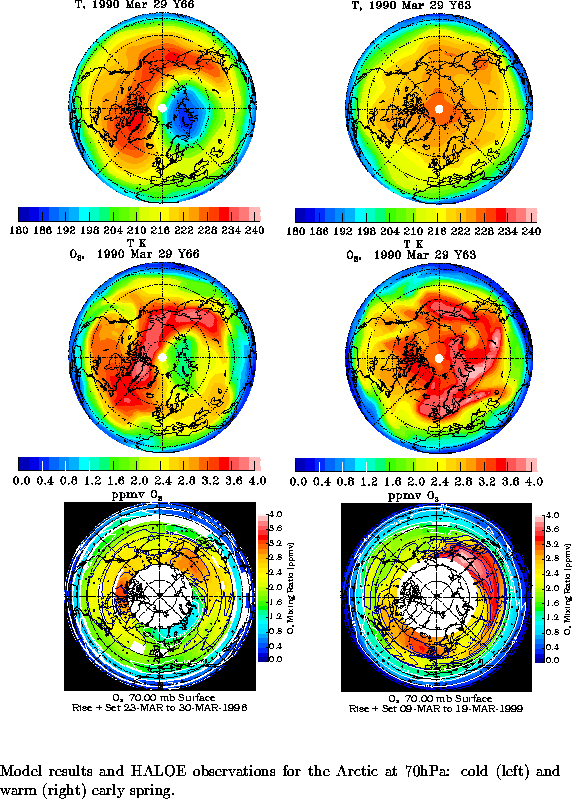
MPI for Chemistry, Mainz
MPI for Meteorology, Hamburg
FIGURES
Abstract
Three 20-year simulations with the chemical middle atmosphere circulation model MA-ECHAM-CHEM with boundary conditions representative for the sixties, nineties and about 30 years in the future are evaluated. We focus on feedback processes between radiative heating, water vapor and ozone depletion at polar stratospheric clouds in the lower stratosphere of polar spring in both hemispheres. The simulations include analysis of the impact of changes in PSC particle sedimentation due to temperature and water vapor changes, changes of the mean circulation (large scale descent), stability of the polar vortices, changes in large scale wave patterns, and interannual variability. The presentation includes an intercomparison of the simulations for the nineties with 8 years of HALOE/UARS satellite data, and also intercomparison of modelled and observed (Berlin data) temperature trends in the Arctic lower stratosphere.
The Model
The fully interactive chemical circulation model for the middle atmosphere MAECHAM4-CHEM (Roeckner et al, 1996) has a horizontal resolution of T30 (6oX 6o). Its very efficient chemical scheme (Steil et al, 1998) applies the 'family technique' and includes solid Polar Stratospheric Cloud (PSC) particles with their surface as function of temperature, water vapor and nitric acid. Settling is taken into account. Photolysis rates are computed every chemical timestep using the fast scheme of Landgraf and Crutzen (1999). The model has an improved version of the gravity wave parameterization of Manzini and McFarlane (1998) which leads to stratospheric temperatures very close to observations throughout the year. In the 3 performed 20 year-'time-slice' experiments the lower boundary conditions, including sea surface temperature, were fixed.
Results and Conclusions
Comparisons with UARS-HALOE-satellite data show that MA-ECHAM-CHEM is able to reproduce the main features of temperature, ozone and water vapor distributions in stratosphere and lower mesosphere. The discussion of results focusses on the 70 to 50hPa region of the polar vortices in winter and spring.

Figure 1
Modelled ozone and temperature for the nineties in the lower stratosphere of the polar vortices (upper four panels, subset covering extremes) agree well with UARS/HALOE satellite observations (lower panels), including interannual variability (slight high bias in ozone because of too much transport from the production area in low latitudes).


Figures 2 and 3
Almost realistic PSC-distributions (lower panels, 15 years average, despite only solid PSCs) compared to SAM-observations (upper panel, Poole and Pitts, 1994) are calculated, however somewhat overestimated in the upper part of the lower stratosphere due to a slight cold bias of model and in the lowermost part due to too much diffusion of water vapor from the troposphere. PSCs in individual years are consistent with the development of ozone. Mid winter warmings are simulated in the Arctic.
Settling of ice particles in Antarctic winter causes realistic dehydration and downward transport of HNO3 in the lower stratosphere (not shown, paper in preparation).

Figure 4
Change in PSC-probability from 1960 to 1990, Antarctic left, Arctic right.

Figure 5
Same for 1990 to 2030.
Cooling of stratosphere by greenhouse gases causes earlier onset of PSCs comparing 1960 with 2030. Antarctic PSCs persist longer in 1990 due to ozone feedback.
The following set of figures shows how the mean values and standard deviations in the polar vortices change in the different 'time slice' experiments.
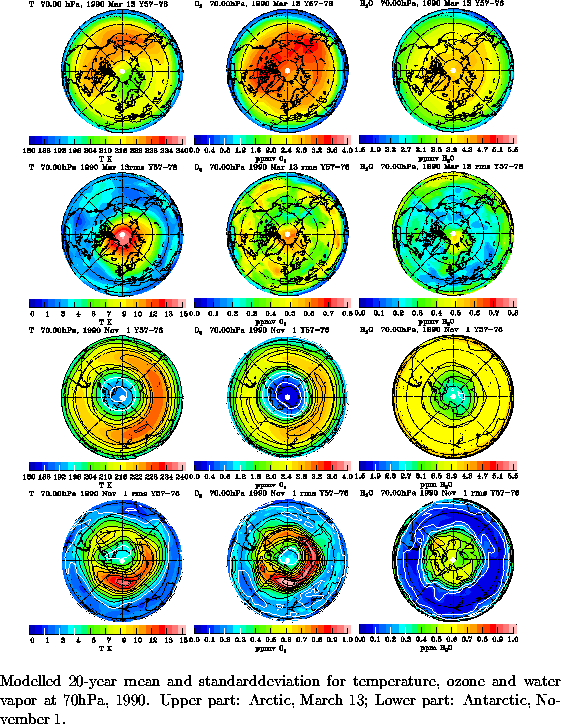
Figure 6
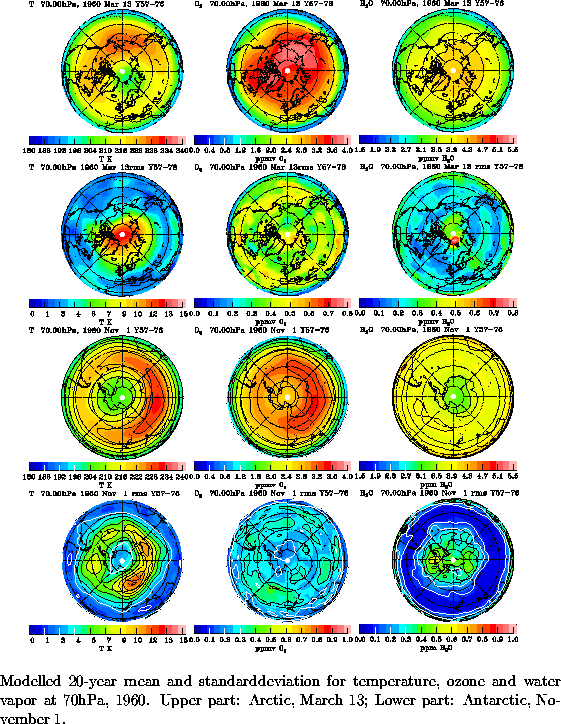
Figure 7
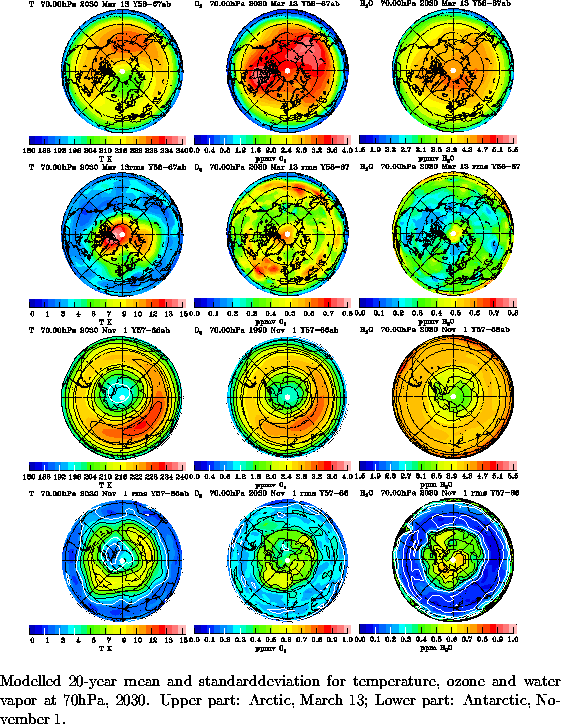
Figure 8
Variability in the lower stratosphere is amplified by ozone and water feedback (via PSCs and radiative heating) and largest near the pole in the Arctic (March) and around 60o in Antarctic (September to late October), as observed. In 2030 it looks like, that a position of the Arctic vortex near Europe is more likely than in the present.
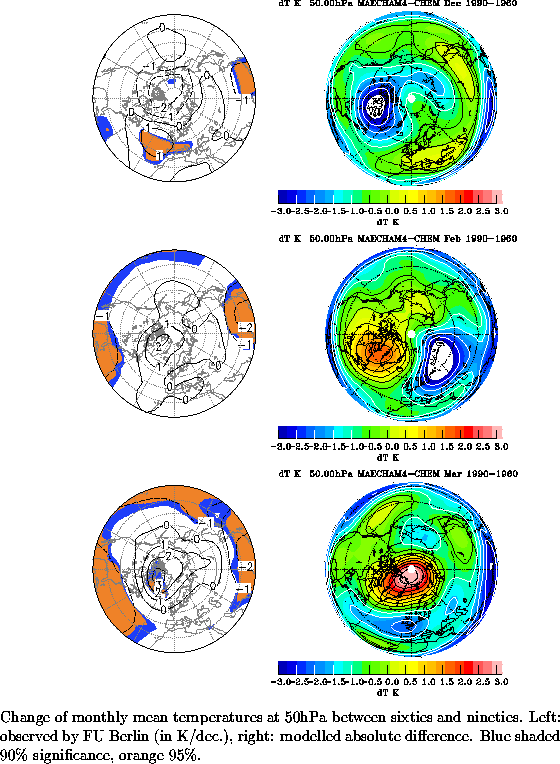
Figure 9
Patterns of temperature trends from sixties to nineties are similar to Berlin data, except the overestimate of modelled cooling near Russia in February. Warming near the pole is calculated and observed in March, cooling in winter.
Temperature changes in the middle and upper stratosphere in high latitudes are significantly modified by changes in the mean circulation (descent rate, see Poster by Manzini et al, P/3-1.5).
Recovery of ozone due to chlorine reductions is calculated for 2030, increase of variability computed for North Atlantic and Asia, but not Northern Europe (most likely position of vortex). A Northern ozone hole is not likely, at least not for the 2030 conditions. A further run with 2015 conditions, which have still chlorine as high as 1990 but enhanced stratospheric cooling by CO2 is to be evaluated for that aspect.
Acknowledgements
We thank the HALOE team at NASA Langley, Hampton, VA, and the Free University of Berlin for providing data. This study was supported by the German Research Ministery (BMBF/9517).
References
Landgraf,J, P.J. Crutzen, An efficient method for online calculations of photolysis and heating rates, J. Atmos. Sci. 55, 863-878, 1998.
Manzini, E., N.A. McFarlane, The effect of varying the source spectrum of a gravity wave parametrization in a middle atmosphere general circulation model, J. Geophys. Res., 103, 31523-31539, 1998.
Poole, L.R. and M.C. Pitts, Polar stratospheric cloud climatology basd on Stratospheric Aerosol Measurement II observations from 1978 to 1989. J. Geophys. Res. 99, 13083-13089, 1994.
Roeckner, E., K. Arpe, L. Bengtsson, L. Christoph, M. Claussen, L. Dümenil, M. Esch, M. Giorgetta, U. Schlese, U. Schulzweida, The atmospheric general circulation model ECHAM-4: Model description and simulation of present-day climate, Report No. 218, Max-Planck-Institut für Meteorologie, Hamburg, 1996.
Steil, B., M. Dameris, C. Brühl, P.J. Crutzen, V. Grewe, M. Ponater, R. Sausen, Development of a chemistry module for GCMs: first results of a multi-annual integration, Ann. Geophys., 16, 205-228, 1998.
Back to
| Session 1 : Stratospheric Processes and their Role in Climate | Session 2 : Stratospheric Indicators of Climate Change |
| Session 3 : Modelling and Diagnosis of Stratospheric Effects on Climate | Session 4 : UV Observations and Modelling |
| AuthorData | |
| Home Page | |